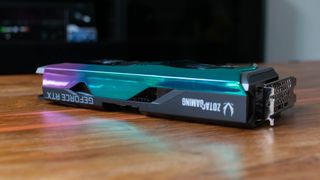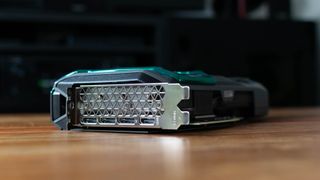IT Pro Verdict
Pros
- +
Excellent value
Cons
- -
No USB-C port
- -
Mediocre scientific and engineering performance










It’s been a tough year for IT departments, particularly when it comes to purchasing. First, lockdowns left organisations scrambling to pick up laptops for staff, and now there’s a worldwide shortage of graphics cards. While AMD and Nvidia both offer dedicated professional GPUs for workloads like video rendering, 3D modelling or CAD, many businesses that rely on these workloads choose to save money by instead opting for consumer-level cards, which often offer broadly capable performance for these kinds of tasks.
Currently, however, this means fighting with consumers over the scant remaining supplies of cards like the RTX 3070, which are now in incredibly high demand thanks to a number of factors including COVID-related manufacturing delays and a surge in interest. Part of the reason behind this surge is the performance boost promised by Nvidia’s new 3000-series units; featuring an 8nm manufacturing process, more CUDA cores and new storage technologies, the latest generation is set to be impressively powerful.
Nvidia produces first-party ‘Founders Edition’ versions of all its cards, largely as reference designs and for the benefit of early adopters, but it also allows partners to produce their own versions based on the same base units. These usually have improved cooling to support some level of overclocking, as well as software utilities to control various operational elements. For this review, we’ve tested Zotac’s GeForce RTX 3070 AMP Holo card, but as most partner cards are broadly representative, we’d expect similar performance from any RTX 3070 unit.
It’s built on Nvidia’s latest Ampere architecture, but the main focus isn’t raw GPU performance so much as it is ray-tracing and AI workloads, thanks to its 2nd-generation ray-tracing cores and 3rd generation tensor cores. This is a key example of Nvidia’s true speciality - GPU compute platforms for data centre deployment - bleeding over into its gaming business, and it has some notable implications for organisations looking to use these cards in a commercial context.
Nvidia GeForce RTX 3070 review: Design
The first thing to note about this card is that it’s an absolute monster. Measuring 291 x 142mm, it’s almost 30mm larger than the Founders Edition 3070 in thickness and almost 50mm longer. It also takes up two and a half expansion slots while the Founders Edition uses only two. If you’re planning out a build using this card, you’re going to need to make doubly sure that you’ve got enough space inside your system to fit it in.

Gaming-focused hardware often has a tendency to be a little flashy and overdesigned, but thankfully this card is one of the more sedate examples. The iridescent purple and turquoise casing is a touch more garish than would be ideal in a business context and it isn’t as elegant as Nvidia’s stock design, but it’s not unattractive.
It is, however, decked out with the traditional RGB lighting elements. These can be customised via Zotac’s Firestorm software utility - including turning them off altogether, if you’d rather your workstation didn’t glow like Blackpool illuminations.
Cooling is handled by a pair of 11-blade fans, combined with fin-stack aluminium heatsinks and six copper heat pipes for maximising heat distribution across the card, while power comes courtesy of two eight-pin connectors. This card consumes a substantial 240W of electricity, and demands a 650W PSU to run.
Nvidia GeForce RTX 3070 review: Specs and performance
The RTX 3070 supposedly represents a substantial leap forward for graphics technology, and it’s got the specs to back that up; its 5,888 CUDA cores are more than double the amount boasted by its immediate predecessor, the RTX 2070, as well as an increase of 26% compared to the previous top-end card, the 2080 Ti. It’s also fitted with 8GB of GDDR6 graphics memory, as well as a boost clock of 1,785MHz and support for PCIe 4.
So how much graphical oomph does all of that get you? The answer, as it turns out, is a fair bit. We benchmarked the 3070 on our test rig, kindly provided by Chillblast, with an AMD Ryzen 5 5600X processor and 32GB of RAM, and it put in a capable showing in most areas. 3D rendering was a runaway strength, as demonstrated by a score of 11,916 in LuxMark 3.1’s OpenCL GPU rendering task - more than 30% better than the RTX 2080 Ti, and over double what the professional-grade RTX 4000 achieved when we tested it in Acer’s ConceptD 500 workstation.

Similarly, its score of 412 in OctaneBench 2020 was 15% faster, as was its 287 score in the 3ds Max portion of the SPECviewperf professional workload benchmarks. These results, along with a score of 385 for the Maya test, illustrate that this card is as powerful as you’d expect for workloads like rendering and 3D modelling within the media and entertainment sectors.
Unfortunately, things aren’t so rosy when we move over to some of the other use-cases covered by the SPECviewperf tests. Lacklustre results of 252 and 129 in the Creo and SolidWorks tests show that this is not a system that’s well-suited for CAD tasks, while results of 24 and 179 for Siemens NX and Catia mean it’s downright poor for engineering simulations.
These tests were run using Nvidia’s gaming-focused drivers, but the company also allows users to switch over to its professional-focused ‘studio drivers’ at will, increasing support for professional applications without needing a specifically pro-focused card. Sadly, switching to these drivers had no measurable impact on the 3070’s benchmark results, so don’t count on software tweaks to improve any lacklustre performance in more niche workloads.
As with most of Nvidia’s consumer-focused cards, this is a great option for professional media creation or those working in the entertainment industry, but the differences in the actual silicon design between consumer cards like this and the enterprise-focused models is clear. Anyone conducting more rigorous simulations for industries like product design or science is advised to look at cards built specifically for those fields.
Nvidia GeForce RTX 3070 review: Ports and features
The 3070 supports up to four displays via three DisplayPort 1.4a ports and one HDMI 2.1 port, with a maximum resolution of 7,680 x 4,320 at 60Hz. Sadly, there’s no USB-C port, as seen on previous RTX cards. That’s because this port was part of the short-lived VirtualLink standard, designed to allow VR headsets to be connected to the GPU with just one cable. However, the port functioned perfectly well for connecting USB-C monitors, peripherals and other devices, so it’s a shame to see it ditched.

Elsewhere, there’s support for technologies like Nvidia’s DLSS, which uses AI to boost framerates while gaming, and the OpenGL 4.6 standard. Sadly, however, as of the most recent generation, Nvidia is phasing out support for multi-GPU configurations, which means that neither SLI nor Nvidia’s successor technology NVLink is supported. If you want that, you’ll need to seek out Nvidia’s top-end RTX 3090.
Nvidia GeForce RTX 3070 review: Verdict
Given the insane level of demand surrounding Nvidia’s newest GPUs, any business seeking to procure one may find itself faced with a challenging task. In the case of the 3070, however, it’s worth persevering. It may not handle scientific and engineering workloads as well as dedicated enterprise-grade graphics cards, but the boost it offers in media-based 3D modelling performance is significant.
It’s even more tempting considering the sub-£600 price, and the fact that the 2080 Ti - which it comfortably surpasses - cost north of a grand when it first launched. That kind of value is hard to argue with. We wouldn’t blame you for waiting until the GPU fever dies down, but if you manage to find an RTX 3070 to power your rendering workstation, you certainly won’t be disappointed.
Zotac GeForce RTX 3070 AMP Holo specifications
| Stream processors | 5,888 |
| Base clock | 1.5GHz |
| Boost clock | 1785MHz |
| Memory | 8GB GDDR6 |
| Connectivity | PCIe 4.0 16x |
| Display outputs | 3 x DisplayPort 1.4, 1 x HDMI 2.1 |
| Max resolution | 7680 x 4320 @60Hz |
| TDP | 240W |
| Power connections | 2 x 8-pin |
| Supported APIs | Microsoft DirectX 12 Ultimate, Vulkan RT API, OpenGL 4.6 |
Adam Shepherd has been a technology journalist since 2015, covering everything from cloud storage and security, to smartphones and servers. Over the course of his career, he’s seen the spread of 5G, the growing ubiquity of wireless devices, and the start of the connected revolution. He’s also been to more trade shows and technology conferences than he cares to count.
Adam is an avid follower of the latest hardware innovations, and he is never happier than when tinkering with complex network configurations, or exploring a new Linux distro. He was also previously a co-host on the ITPro Podcast, where he was often found ranting about his love of strange gadgets, his disdain for Windows Mobile, and everything in between.
You can find Adam tweeting about enterprise technology (or more often bad jokes) @AdamShepherUK.
